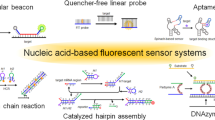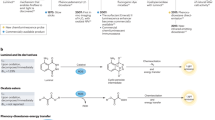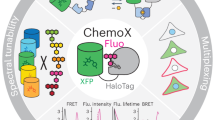Abstract
Ozone exposure is a growing global health problem, especially in urban areas. While ozone in the stratosphere protects the earth from harmful ultraviolet light, tropospheric or ground-level ozone is toxic and can damage the respiratory tract. It has recently been shown that ozone may be produced endogenously in inflammation and antibacterial responses of the immune system; however, these results have sparked controversy owing to the use of a non-specific colorimetric probe. Here we report the synthesis of fluorescent molecular probes able to unambiguously detect ozone in both biological and atmospheric samples. Unlike other ozone-detection methods, in which interference from different reactive oxygen species is often a problem, these probes are ozone specific. Such probes will prove useful for the study of ozone in environmental science and biology, and so possibly provide some insight into the role of ozone in cells.
This is a preview of subscription content, access via your institution
Access options
Subscribe to this journal
Receive 12 print issues and online access
$259.00 per year
only $21.58 per issue
Buy this article
- Purchase on Springer Link
- Instant access to full article PDF
Prices may be subject to local taxes which are calculated during checkout





Similar content being viewed by others
Change history
10 March 2010
In the version of this Article originally published, some of the images for the different parts in Fig. 4 were incorrectly placed. The correction has been made in the HTML and PDF versions of the Article. A Supplementary film was also missing online, this has now been uploaded.
References
Smith, L. L. Oxygen, oxysterols, ouabain, and ozone: a cautionary tale. Free Radical Biol. Med. 37, 318–324 (2004).
Wentworth, Jr, P. et al. Evidence for antibody-catalyzed ozone formation in bacterial killing and inflammation. Science 298, 2195–2199 (2002).
Babior, B. M., Takeuchi, C., Ruedi, J. M., Gutierrez, A. & Wentworth, Jr, P. Investigating antibody-catalyzed ozone generation by human neutrophils. Proc. Natl Acad. Sci. USA 100, 3031–3034 (2003).
Wentworth, Jr, P. et al. Evidence for ozone formation in human atherosclerotic arteries. Science 302, 1053–1056 (2003).
Takeuchi, K. & Ibusuki, T. Quantitative determination of aqueous-phase ozone by chemiluminescence using indigo-5,5′-disulfonate. Anal. Chem. 61, 619–623 (1989).
Kettle, A. J., Clark, B. M. & Winterbourn, C. C. Superoxide converts indigo carmine to isatin sulfonic acid. J. Biol. Chem. 279, 18521–18525 (2004).
Sies, H. Ozone in arteriosclerotic plaques: searching for the ‘smoking gun’. Angew. Chem. Int. Ed. 43, 3514–3515 (2004).
Kettle, A. J. & Winterbourn, C. C. Do neutrophils produce ozone? BioFactors 24, 41–45 (2005).
Pryor, W. A. et al. Free radical biology and medicine: it's a gas, man! Am. J. Physiol. Regul. Integr. Comp. Physiol. 291, R491–R511 (2006).
Yamashita, K. et al. Ozone production by amino acids contributes to killing of bacteria. Proc. Natl Acad. Sci. USA 105, 16912–16917 (2008).
Horvath, M., Bilitzky, L. & Huttner, J. Ozone (Elsevier, 1985).
Jimenez, A. M., Navas, M. J. & Galan, G. Air analysis: determination of ozone by chemiluminescence. Appl. Spectrosc. Rev. 32, 141–149 (1997).
Parrish, D. D. & Fehsenfeld, F. C. Methods for gas-phase measurements of ozone, ozone precursors and aerosol precursors. Atmos. Environ. 34, 1921–1957 (2000).
Williams, E. J. et al. Comparison of ultraviolet absorbance, chemiluminescence, and DOAS instruments for ambient ozone monitoring. Environ. Sci. Technol. 40, 5755–5762 (2006).
Kuczkowski, R. L. 1,3-Dipolar Cycloaddition Chemistry (John Wiley, 1984).
Maruo, Y. Y. Measurement of ambient ozone using newly developed porous glass sensor. Sens. Actuat., B 126, 485–491 (2007).
Li, J., Li, Q., Dyke, J. V. & Dasgupta, P. K. Atmospheric ozone measurement with an inexpensive and fully automated porous tube collector-colorimeter. Talanta 74, 958–964 (2008).
Uchiyama, S. & Otsubo, Y. Simultaneous determination of ozone and carbonyls using trans-1,2-bis(4-pyridyl)ethylene as an ozone scrubber for 2,4-dinitrophenylhydrazine-impregnated silica cartridge. Anal. Chem. 80, 3285–3290 (2003).
Soh, N. Recent advances in fluorescent probes for the detection of reactive oxygen species. Anal. Bioanal. Chem. 386, 532–543 (2006).
Miller, E. W., Tulyathan, O., Isacoff, E. Y. & Chang, C. J. Molecular imaging of hydrogen peroxide produced for cell signaling. Nature Chem. Biol. 3, 263–267 (2007).
Koide, K. et al. Scalable and concise synthesis of dichlorofluorescein derivatives displaying tissue permeation in live zebrafish embryos. ChemBioChem 9, 214–218 (2008).
Song, F., Watanabe, S., Floreancig, P. E. & Koide, K. Oxidation-resistant fluorogenic probe for mercury based on alkyne oxymercuration. J. Am. Chem. Soc. 130, 16460–16461 (2008).
Song, F., Garner, A. L. & Koide, K. A highly sensitive fluorescent sensor for palladium based on the allylic oxidative insertion mechanism. J. Am. Chem. Soc. 129, 12354–12355 (2007).
Garner, A. L. & Koide, K. Oxidation state-specific fluorescent method for palladium(ii) and platinum(iv) based on the catalyzed aromatic Claisen rearrangement. J. Am. Chem. Soc. 130, 16472–16473 (2008).
Garner, A. L. & Koide, K. Fluorescent method for platinum detection in buffers and serums for cancer medicine and occupational hazards. Chem. Commun. 83–85 (2009).
Garner, A. L. & Koide, K. Studies of a fluorogenic probe for palladium and platinum leading to a palladium-specific detection method. Chem. Commun. 86–88 (2009).
Garner, A. L., Song, F. & Koide, K. Enhancement of a catalysis-based fluorometric detection method for palladium through rational fine-tuning of the palladium species. J. Am. Chem. Soc. 131, 5163–5171 (2009).
Chang, M. C. Y., Pralle, A., Isacoff, E. Y. & Chang, C. J. A selective, cell-permeable optical probe for hydrogen peroxide in living cells. J. Am. Chem. Soc. 126, 15392–15393 (2004).
Mueller, S., Riedel, H-D. & Stremmel, W. Determination of catalase activity at physiological hydrogen peroxide concentrations. Anal. Biochem. 245, 55–60 (1997).
Imlay, J. A. Cellular defenses against superoxide and hydrogen peroxide. Annu. Rev. Biochem. 77, 755–776 (2008).
Deisseroth, A. & Dounce, A. L. Catalase: physical and chemical properties, mechanism of catalysis, and physiological role. Physiol. Rev. 50, 319–375 (1970).
Clennan, E. L. & Pace, A. Advances in singlet oxygen chemistry. Tetrahedron 61, 6665–6691 (2005).
Sawyer, D. T. & Valentine, J. S. How super is superoxide? Acc. Chem. Res. 14, 393–400 (1981).
Bailey, P. S. Ozonation in Organic Chemistry: Olefinic Compounds (Academic Press, 1978).
Pryor, W. A. How far does ozone penetrate into the pulmonary air/tissue boundary before it reacts? Free Radical Biol. Med. 12, 83–88 (1992).
Pryor, W. A. Mechanisms of radical formation from reactions of ozone with target molecules in the lung. Free Radical Biol. Med. 17, 451–464 (1994).
Mudway, I. S. & Kelly, F. J. Ozone and the lung: a sensitive issue. Mol. Aspects Med. 21, 1–48 (2000).
Soini, E. & Hemmila, I. Fluoroimmunoassay: present status and key problems. Clin. Chem. 25, 353–361 (1979).
Weschler, C. J. Ozone's impact on public health: contributions from indoor exposures to ozone and products of ozone-initiated chemistry. Environ. Health Perspect. 114, 1489–1496 (2006).
Weschler, C. J. Ozone in indoor environments: concentration and chemistry. Indoor Air 10, 269–288 (2000).
Ely, J. C. et al. Implications of platinum-group element accumulation along U.S. roads from catalytic-converter attrition. Environ. Sci. Technol. 35, 3816–3822 (2001).
Nemec, A. A., Leikauf, G. D., Pitt, B. R., Wasserloos, K. J. & Barchowsky, A. Nickel mobilizes intracellular zinc to induce metallothionein in human airway epithelial cells. Am. J. Resp. Cell Mol. Biol. doi:10.1165/rcmb.2008-0409OC (2009).
Acknowledgements
We acknowledge support from the US National Science Foundation (to K.K.) and the US National Institutes of Health (to C.M.S., B.R.P. and G.D.L). We thank Yang Gao for determining the specificity of compound 8 for ozone.
Author information
Authors and Affiliations
Contributions
A.L.G., C.M.S., B.R.P, G.D.L. and K.K. designed the experiments. A.L.G. generated the data shown in Figs 2, 3 and 5. C.M.S. generated the data shown in Fig. 4. S.A. synthesized and characterized compound 8. A.L.G., C.M.S. and K.K. wrote the manuscript.
Corresponding author
Supplementary information
Supplementary information
Supplementary information (PDF 1755 kb)
Supplementary information
Supplementary Film S1 (MOV 1358 kb)
Rights and permissions
About this article
Cite this article
Garner, A., St Croix, C., Pitt, B. et al. Specific fluorogenic probes for ozone in biological and atmospheric samples. Nature Chem 1, 316–321 (2009). https://doi.org/10.1038/nchem.240
Received:
Accepted:
Published:
Issue Date:
DOI: https://doi.org/10.1038/nchem.240
This article is cited by
-
A highly sensitive fluorescent probe for ozone based on coumarin-benzothiazole derivative
Journal of Analytical Science and Technology (2021)
-
A diversity-oriented rhodamine library for wide-spectrum bactericidal agents with low inducible resistance against resistant pathogens
Nature Communications (2019)
-
A “turn-on” fluorescent sensor for ozone detection in ambient air using protein-directed gold nanoclusters
Analytical and Bioanalytical Chemistry (2017)
-
Sensitive detection of ozone by a practical resorufin-based spectroscopic probe with extremely low background signal
Scientific Reports (2013)
-
Reaction-based small-molecule fluorescent probes for chemoselective bioimaging
Nature Chemistry (2012)



